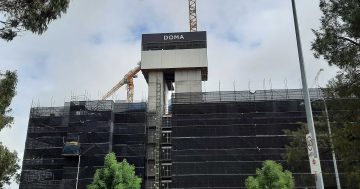
A Banyan Constructions project, The Ridge, at Negus Crescent, Watson. Photo: Independent.
The 150 creditors owed more than $20 million by builder Banyan Constructions are mostly small businesses and sub-contractors whose livelihoods – and in some cases, their homes – are now at risk, according to Master Builders ACT.
Banyan has gone bust in one of the ACT’s biggest residential building company collapses, with Ernst and Young (EY) appointed liquidators on 20 January leaving more than 10 projects incomplete, including half a dozen major townhouse developments.
The company’s 20 staff have also lost their jobs and EY is working with the federal Attorney-General’s Department to access Fair Entitlements Guarantee payments.
Master Builders ACT (MBA) CEO Michael Hopkins said he feared a second wave of closures from Banyan sub-contractors and suppliers if they can’t work through the cashflow problems the collapse creates for their businesses.
“The majority of creditors are small family-owned businesses, so for those sub-contractors and suppliers, many of them will have personal assets including their homes connected to their businesses. They would now be worried about losing [their homes],” he said.
“They have staff they’d be worried about [as well].”
Banyan was working for about three main local developers and Mr Hopkins hoped they could quickly appoint other builders to take on the incomplete projects so the sub-contractors and suppliers could at least continue at these sites.
“That’s not going to help them with money outstanding,” he said. “Most of them will probably never see that money again.”
There are also concerns for home-buyers who may have bought properties off the plan.
Mr Hopkins said he expected the amount owing to rise as the liquidators continue their investigations.
He did not know what had gone wrong for the company but the MBA had passed on reports that members were not being paid to the ACT Building Registrar.
The issue highlighted the ACT Government’s inattention to the strengthening of the licensing regime for builders, something that the MBA, in line with the Shergold Weir Report, had been stressing for some time.
“There is quite a gaping hole in the licensing system where a builder can obtain a licence and get it renewed each year, but the checks on how the business is travelling financially are clearly not working if this can happen,” Mr Hopkins said.
“When we hear of it happening with sub-contractors and suppliers, it’s too late at that point. If there is no money in the company to be recovered it’s all a bit too late.”
Mr Hopkins said Shergold and Weir identified the issue of licensing and registration in their Building Confidence Report in 2018, yet this recommendation remained incomplete in the ACT.

Banyon founder and managing director Liam Kelly. Photo: LinkedIn.
“Banyan Constructions builder’s licence had been renewed by the ACT Government year after year with the renewal process failing to identify problems with the company’s business practices,” he said.
Mr Hopkins said that in other jurisdictions such as Queensland, the regulator can check the assets and workload of a company to ensure they are not stretched too thin and have the financial capacity to complete projects.
“It highlights that with all this talk of trying to improve building quality it’s not only the quality of the workmanship that we need to be looking at but also the conduct of the business and the business management skills of the owners,” he said. “That’s just as important as the licence holder’s ability to actually compete quality building work.”
He called on the Government to focus on implementing the Building Confidence report’s recommendation.
The MBA expected the Banyan Construction collapse to generate calls to introduce project bank accounts or trust accounts, but Mr Hopkins said these reforms had proven ineffective in other jurisdictions.
But Jason O’Meara from the CFMEU believes project trust accounts would ensure money that was meant to finance a development could not be used for other purposes, protecting the interests of workers and sub-contractors.
He said developers also needed to do more due diligence so they knew builders were capable of completing a project and were not biting off more than they could chew.
It was still too easy for builders to lose their licence and yet pay to use somebody else’s and re-emerge elsewhere and still control the sites and money.
Mr Hopkins said the collapse was the last thing the industry needed after the bushfires, smoke and uncertainty associated with coronavirus.
He added that while the ACT industry was highly competitive and there was a lot of cost pressures on builders and sub-contractors, none of that excused a company collapsing owing $20 million.
The MBA is a creditor and owed $800, but Mr Hopkins said it would not be seeking to recover the money.
An ACT Government spokesperson said the Government became aware of the situation only after Banyan went into liquidation.
The spokesperson said builders whose companies go into liquidation had their licences suspended automatically, and after three months a licence could be cancelled if the company remained in this state.
”Should the builder apply for a new licence with a new company, their history will be assessed and considered as a factor of whether they should be granted a new licence,” the spokesperson said.
The current reform program included a review of the security of payment scheme in the ACT, which is considering models for protection of payments to subcontractors.
The Government was also looking at a developer licensing scheme, including examining the role of parties contracting for the sale of off the plan units, the practice of phoenixing between builders and developers and security of payment issues.
”Future decisions on changes to the security of payments system, the introduction of project trust accounts, the developer licensing scheme and any supporting legislation will be informed by consultation,” the spokesperson said.
EY has issued a preliminary report to creditors and will call a meeting of creditors to present the findings of their investigations in the coming weeks.
Banyon founder and managing director Liam Kelly is uncontactable and the Banyan website and Facebook page content cannot be accessed.




















